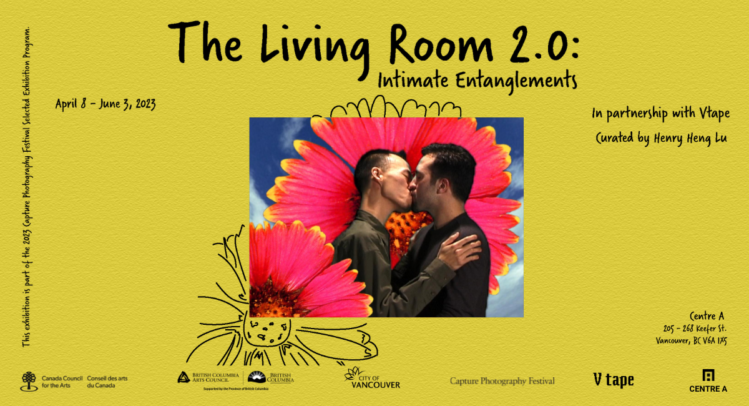
The Living Room 2.0: Intimate Entanglements
–
April 8 – June 3, 2023
Curated by former Executive Director/Curator Henry Heng Lu
–
Current Gallery Hours:
Wednesday to Saturday, 12 PM – 6 PM*
*Subject to change as per COVID-19-related protocols. Face masks or face coverings are recommended.
–
In 2022, Centre A initiated the experiential project “The Living Room” for which the gallery space was transformed into a furnished living room space. Visitors had the opportunity to sit down in the makeshift living room to watch a selection of films and videos. By converting the gallery rooms into a (semi-)domestic space, we hope to demystify and challenge the oftentimes inaccessible nature of a contemporary art gallery. Throughout the exhibition-installation, we organized a series of public programs and events, such as dance parties, film screenings, and food sharing, to activate the living room and welcome guests of all backgrounds.
In 2023, we will bring back The Living Room with a new set of film programs. From April to June 2023, we will present a program titled Intimate Entanglements. Presented in partnership with Vtape, the films selected orient towards storytelling and the agency of the self or of the community, by way of musicality, rhythm, and tempo.
The films will be playing on loop during The Living Room.
This exhibition is part of the 2023 Capture Photography Festival Selected Exhibition Program.
–
The Program
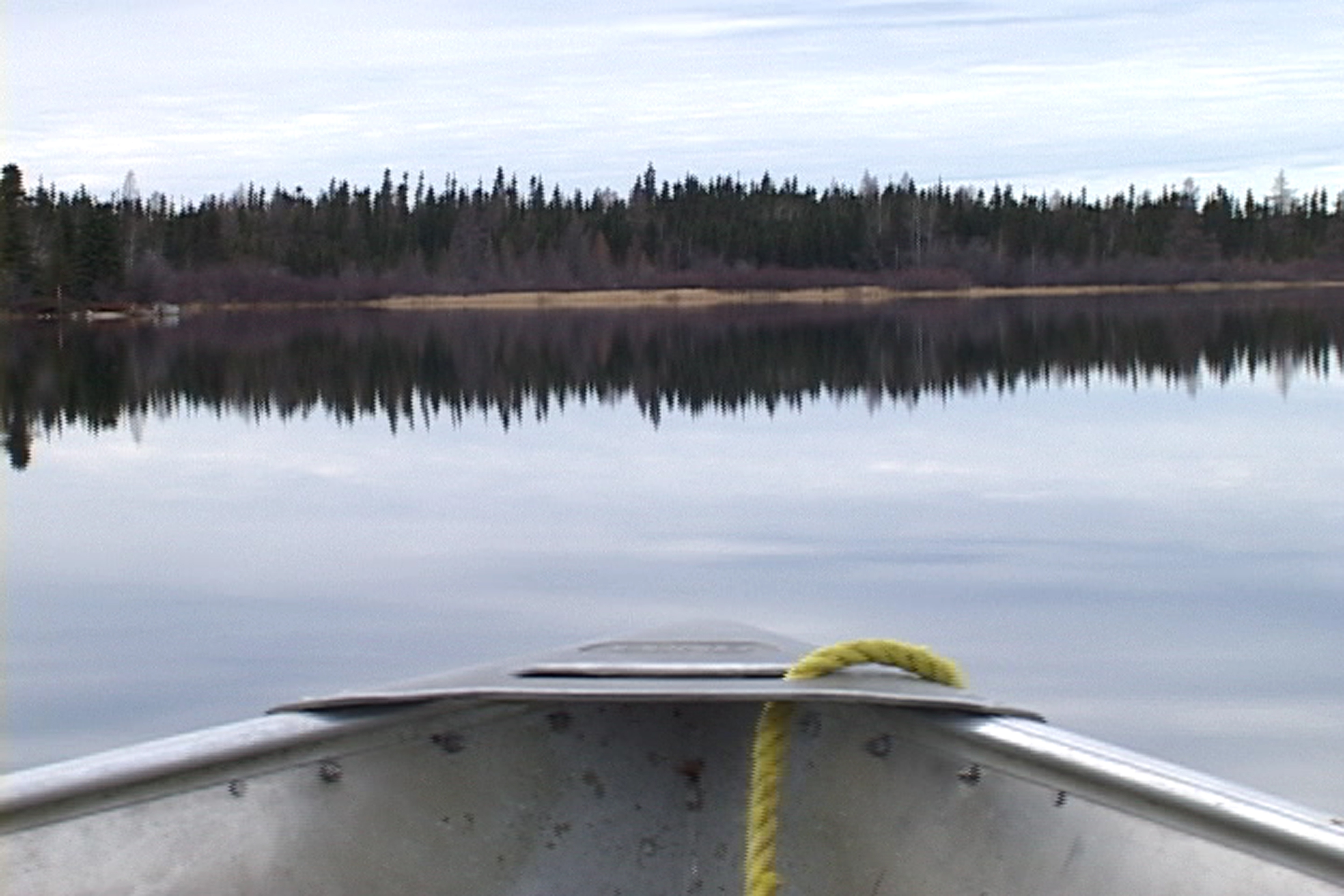
Kevin Lee Burton– Nikamowin (Song) (2017), 11:15 minutes, colour, Cree / English
A linguistic soundscape comprised of the deconstruction and reconstruction of Cree narration dances with various manipulated landscapes. This audio-visual experiment begs questions of how languages exist, emerge, and survive. It is obvious that the altered and constructed Cree that the director ‘speaks’ in this film is not one that conforms to the traditional constructs of the Cree language, but it does resonate deep enough to make us feel like we are hearing something that we truly understand – a message that begs lost language speakers to hear their inner song of pride so they can bring back the language that lives alone waiting in the darks of their spirits.
Kevin Lee Burton (Swampy Cree) is an award-winning multidisciplinary artist from God’s Lake Narrows, MB. Starting out in film+video, Kevin has migrated into various art genres including Interactive, Installation, Photography & Social Work. Kevin’s work focuses on Indigenous expression and celebration. Aside from his Directorial work, Kevin has engaged in the Arts in various capacities from creator/collaborator on projects to office administration. Kevin has worked as program assistant for the Native and Indigenous Initiative at the Sundance Institute in Beverly Hills, California; as associate programmer for Out On Screen’s IndigeQUEER program in Vancouver; program facilitator for various Indigenous focused programs across Canada, and is also a founding member of the ITWE Collective. Formally trained through all-Aboriginal training Programs in the Indigenous Independent Digital Filmmaking Program and through the Indigenous Media Arts Group in Vancouver, Kevin has been carving a niche in working with his ancestral language, Cree.
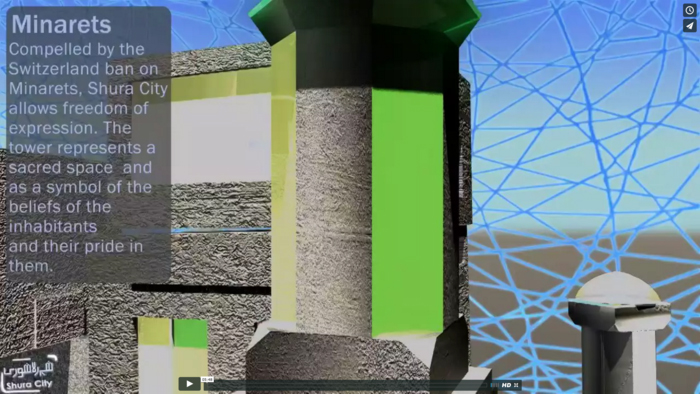
hiba ali– A Proposal for Anti-Drone Architecture: Shura City (2013), 05:48 minutes, colour, English.
Collaboration with Asher Kohn and ?+? CHAiT. In response to drone attacks and unlawful use of surveillance, a proposed city, Shura City, exists as an alternative city-state model. The polity’s citizens through collective decision-making are able to live free of intrusion by state forces and enable us to think about the value of security and privacy.
hiba ali is a producer of moving images, sounds, garments and words. they reside in many time zones: chicago, toronto and eugene. born in karachi, pakistan, they belong to east african, south asian and arab diasporas. they are a practitioner and (re)learner of swahili, urdu, arabic and spanish languages. they work on two long term art and publication projects: the first being an art-based phd project that examines womyn of colour’s labour, and architecture of surveillance as it exists within the monopoly of amazon (corp.) and the second being a series of works that addresses music, cloth and ritual practices that connect east africa, south asia and the arabian peninsula in the swahili-indian ocean region.
they are an assistant professor at the college of design in the art & technology program at the university of oregon in eugene and they teach on decolonial, feminist, anti-racist frameworks in digital art pedagogies. currently, they are a phd candidate in cultural studies at queens university in kingston, ontario. their work has been presented in chicago, stockholm, vienna, berlin, toronto, new york, istanbul, são paulo, detroit, windsor, dubai, austin, vancouver, and portland. they have written for the following magazines: “c”, the seen, newcity chicago, art chicago, art dubai, the state, medium’s zora, rtv, and topical cream.
*the use of lowercase on this site denotes a turn away from egotism embedded in the english language (danah michele boyd) and towards ideas of the collective (bell hooks) and reminds us of the many realities, names and glyphs that cannot be said in such a colonial language.
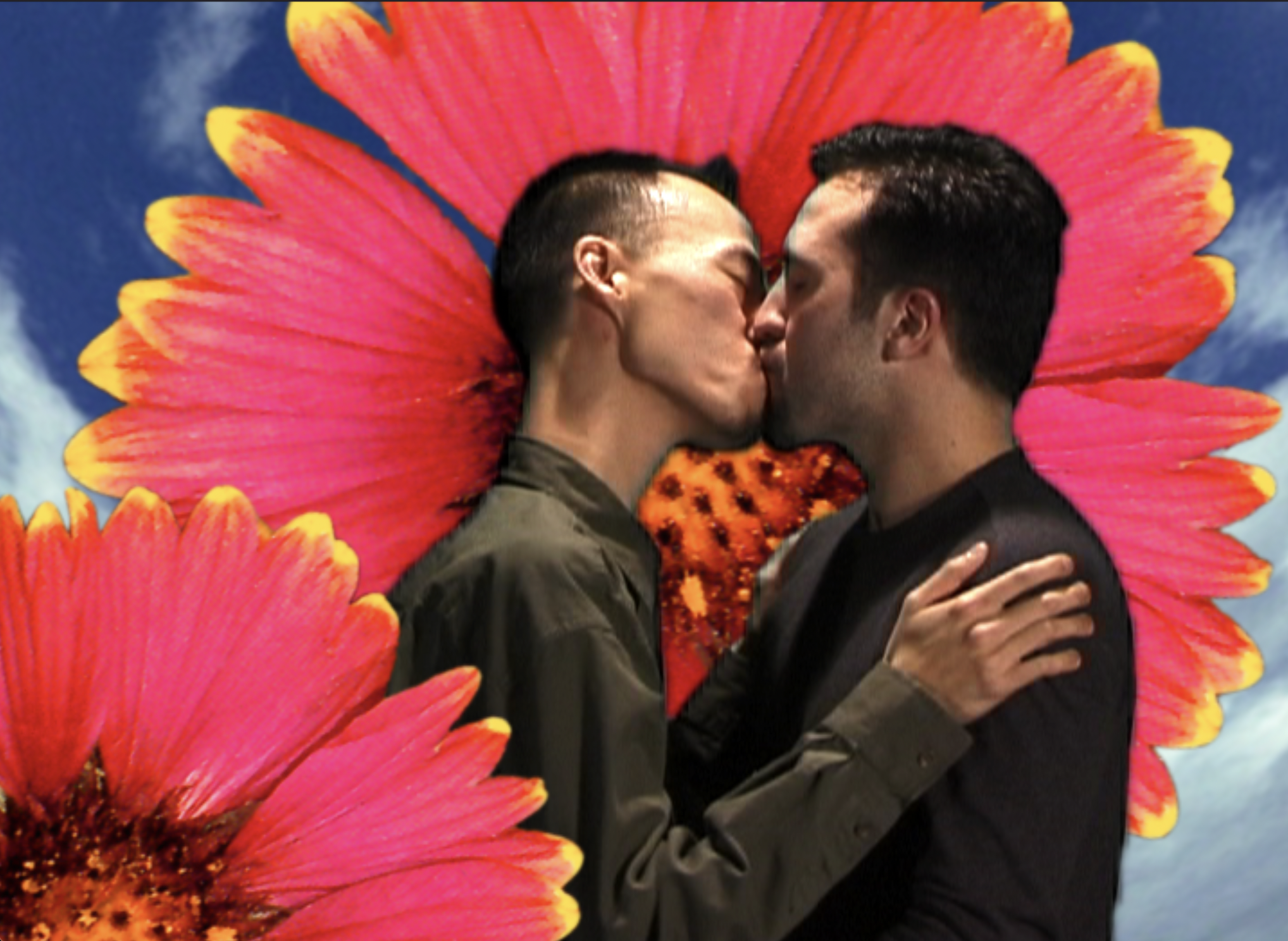
Wayne Yung – Field Guide to Western Wildflowers (2000), 05:30 minutes, colour, Cantonese w English S.T.
The first gay Asian kiss: fantasizing about it, talking about it, doing it. A lush, romantic and highly promiscuous video, featuring sixty-three men in one long kiss.
Wayne Yung was born in 1971 in Edmonton, Canada, to a Chinese immigrant family. He moved to Vancouver in 1994, where he became established as a writer, performer and video artist exploring issues of race and identity from a queer Chinese-Canadian perspective. Arriving in Germany in 2001, he lived in Hamburg and Cologne before settling in Berlin. In addition to his artistic practice, he has also been active as a curator, organizing screening events in North America and Europe. Since his first video release in 1994, he has travelled extensively to present his work at film festivals around the world, including several solo programs.

Roya Akbari – Dancing Mania (2012), 24:49 minutes, Colour, Farsi / English subtitles.
Dancing Mania is a short documentary on the film by Mania Akbari titled, From Tehran to London. The film takes a closer look at Akbari’s boundary pushing film that displays females dancing for the first time in Iranian cinema after the revolution. Dancing Mania not only reviews the evolutionary growth of Akbari as an expressive filmmaker in the constrained atmosphere of Iran, but it intelligently employs stills, stop motion imagery, and backstage footage to capture the depth of the themes that are played out in From Tehran to London. Through a lens of critical analysis with a touch of Freudian psychoanalysis, the documentary comments on how the themes of dance, death, homosexuality, censorship and devastation come to light through the actor’s dialogues and symbols in the film.
Roya Akbari is an artist who works with film and video installations. Her work challenges the ongoing process of colonization in Canada, the experience of alienation of immigrants, and the censorship of autocratic regimes. Akbari obtained her Master of Visual Studies in Studio Art at the University of Toronto. She lives and works in Tkaronto (Toronto) and is currently a Ph.D. candidate in Screen Cultures in the Department of Film and Media at Queen’s University.
Growing up in Tehran, Iran, Akbari started her artistic practice as a photographer. She completed her Bachelor of Fine Arts in Photography at the Emily Carr University of Art and Design. Rooted in experimental documentary as a form, her moving image practice comprises video and installation, and she creates research-based essay films composed of writing, archival footage, and narration. Her work has been presented in artist-run centres, galleries, and film festivals such as Centre A and 221A Artist Run Centre in Vancouver, University of Toronto Art Centre, Centre 3 in Hamilton, Flying Broom International Women’s Film Festival in Turkey, Brussels Women’s Film Festival in Belgium, Fribourg International Film Festival in Switzerland, Edinburgh International Film Festival in Scotland, Bristol Radical Film Festival in UK, TIFF Cinematheque in Toronto, UCLA Film and Television Archive in US, and International Short Film Festival Oberhausen in Germany.
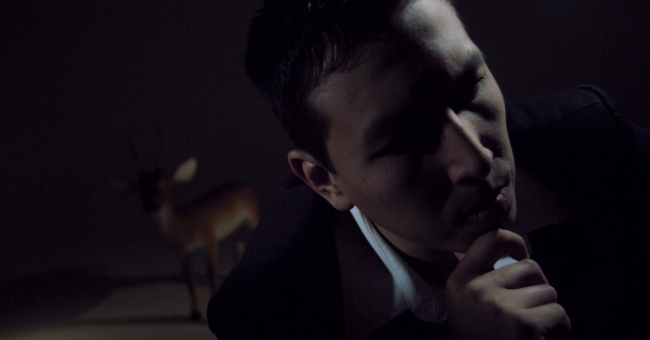
Dana Claxton – He Who Dreams (2013), 50:32 minutes, colour, English.
A supernatural spiritual art film about a man who is in the dreamworld and the real world. The dreamworld and real worlds can be very similar.
Dana Claxton is a critically acclaimed international exhibiting artist. She works in film, video, photography, single and multi- channel video installation, and performance art. Her practice investigates indigenous beauty, the body, the socio-political and the spiritual. Her work has been shown internationally at the Museum of Modern Art (NYC), Metropolitan Museum of Art (NYC), Walker Art Centre (Minneapolis, MN), Sundance Film Festival, Salt Lake City (UT), Eiteljorg Museum of American Indians and Western Art, Indianapolis (IN) and the Museum of Contemporary Art (Sydney, AU), Cyrstal Bridges (Bentonville, AR), with exhibitions at Nasher Gallery of Art at Duke University (Durham, NC), Memphis Brooks Museum of Art (TN) and the Institute of Contemporary Art in Minneapolis (MN).
She is Head and a Professor in the Department of Art History, Visual Art and Theory with the University of British Columbia. She is a member of Wood Mountain Lakota First Nations located in SW Saskatchewan and she resides in Vancouver Canada.
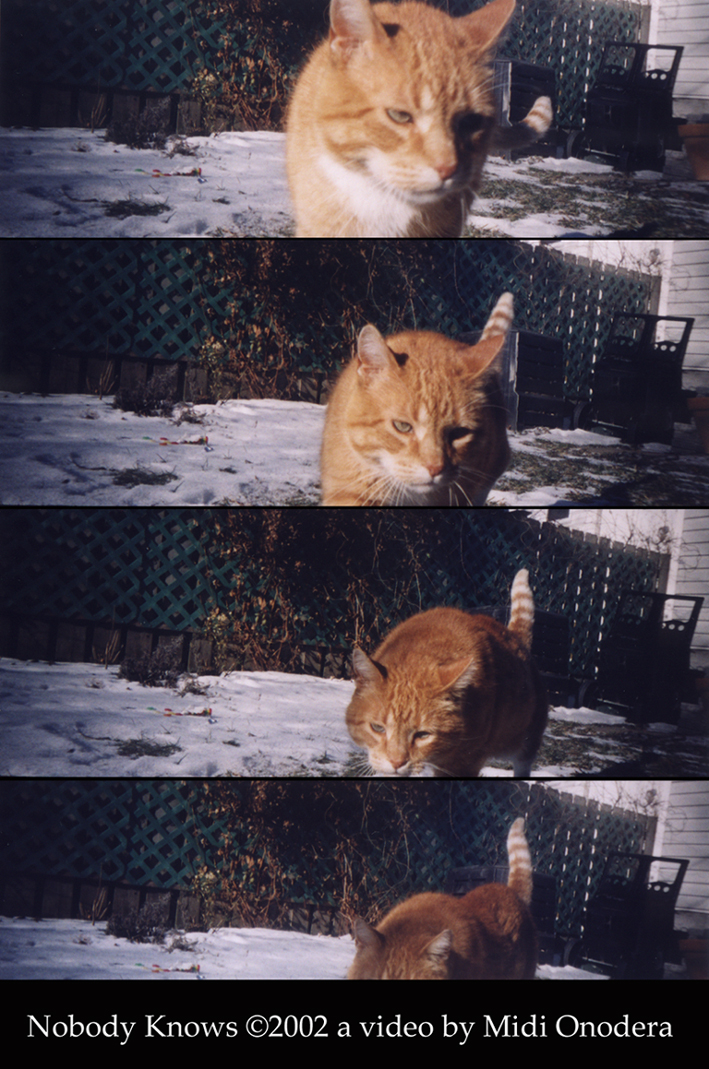
Midi Onodera – Nobody Knows (2001), 03:15 minutes, colour, English
Nobody Knows is a short poetic video that eloquently hints at a few inner thoughts of a solitary young woman. Shot in 2 toy camera formats, the Lomographic 35mm Supersampler and the Intel Play Digital Movie Creator, Nobody Knows embraces alternative photography in both celluloid and the digital realms.
Midi Onodera is an award-winning filmmaker and media artist who has been making films and videos for more than 35 years. She has produced over 25 independent shorts, ranging from 16mm film to digital video to toy camera formats. In 2017 she received the Governor General’s Award in Visual and Media Arts. Skin Deep (1995), her theatrical feature, screened internationally at festivals including the Rotterdam International Film Festival and the Toronto International Film Festival. Her film The Displaced View (1988) was nominated for Best Documentary at the Gemini Awards.
In partnership with Capture Photography Festival and Vtape. Images courtesy of Vtape.

![]()
![]()
![]()

Accessibility: The gallery is wheelchair and walker accessible. If you have specific accessibility needs, please contact us at (604) 683-8326 or [email protected].
Centre A is situated on the unceded territories of the Musqueam, Squamish, and Tsleil-Waututh peoples. We honour, respect, and give thanks to our hosts.









